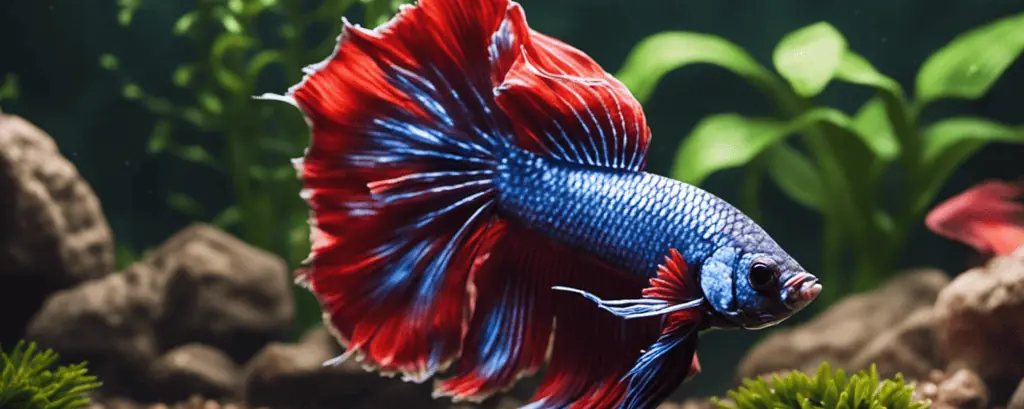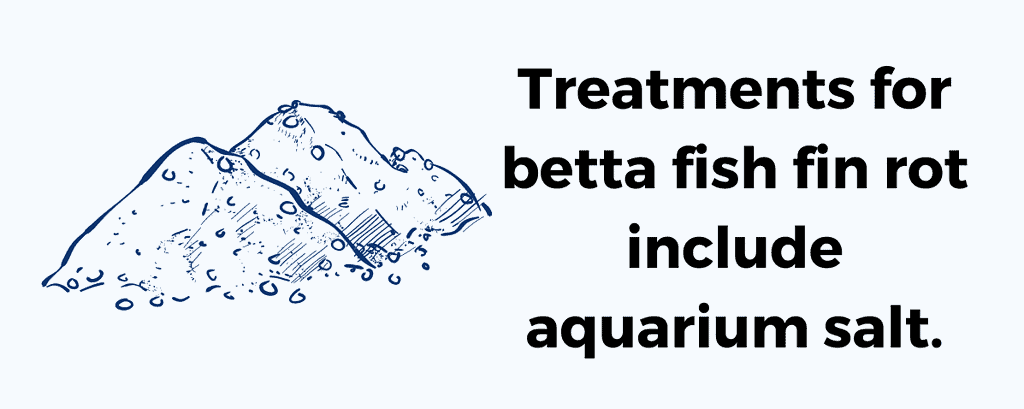Fin rot is one of the most common health problems we see in betta fish.
As the name implies, it causes a betta’s fins to rot away. This leaves jagged edges and sometimes causes black, brown, or white spots to appear on their fins.
Despite being so common, fin rot is very preventable but must be taken seriously!

Table of Contents
Common Causes of Fin Rot in Betta Fish

Many causes of fin rot are common mistakes for beginner aquarists.
Keeping healthy fish is more difficult than you may think. Here is a preliminary list of the ways fin rot can start:
- Poor water quality
- Inadequate tank setup
- Injury
- Stress
- Infections (bacterial/fungal)
- Parasites
Water Quality and Sickness

Maintaining the water parameters in your betta’s tank is crucial to their survival, though.
One of the main causes of fin rot in betta splendens is high ammonia levels.
Poor water quality comes in a variety of packages, though.
Temperature fluctuation, pH irregularities, and nitrite or nitrate imbalances are all possible causes of fin rot.
Water quality declines when there is a build-up of fish waste, plant waste, or leftover food. Things get even worse with poor filtration in the tank and inconsistent cleaning or water changes.
There are several ways these problems are harmful to your fish. Fin rot is just one possible outcome of neglect.
Remember, fin rot is not always a sign of poor water quality. This is just a good place to start.
Check the water parameters in your tank with a thermometer and water testing strip.
Poor Tank Setup, Stress & Injury

Set up your betta’s tank, so they are both safe and comfortable.
This means providing lots of safe freshwater plant species for them. You may choose to use artificial plants instead. They must be soft silk if you do.
Hard materials may injure your betta. Once a betta’s fin is torn, they are more susceptible to fin rot and other illnesses.
Injury happens in other ways, of course. A tank mate might injure a betta who is kept with a larger or more aggressive fish.
Before you make additions to the environment, make sure you will be able to maintain water quality and keep your betta safe with the change.
For example, betta fish like a gravel substrate. But this means using a gravel vacuum from time to time.
Otherwise, you may see oxygen deprivation, ammonia spikes, and other issues.
Whenever you run the risk of injury or illness, you are also encouraging stress in your betta.
Stress leaves fish vulnerable to illnesses but also causes physical changes in and of itself.
If you see stress stripes or other color changes in your betta, check up on their environment.
These are signs something is stressing them out.
Infected Fish

Fin rot is always possible when your betta is sick with parasites or an infection.
Some parasites and bacteria create open wounds on your betta’s body. This is one way they become more susceptible to fin rot.
Any kind of fish disease can potentially leave your betta fish unable to fend off other illnesses as well.
Illness also impacts how they interact with the environment.
If dropsy or bloat gives your fish swimming troubles, they may struggle to get oxygen from the surface as usual.
When an infection causes lethargy or appetite changes, your betta loses out on exercise and much-needed protein.
Symptoms of Fin Rot in Betta Fish

Fin rot shares specific symptoms with other betta health problems.
But it has some defining characteristics to help you recognize it for what it is!
Fin rot causes symptoms such as:
- Fins with frayed/ragged edges
- Red/inflamed/bloody fin edges
- Disintegrating fins
- Black/white/brown fins
- Loss of appetite
- Lethargy
All kinds of health problems or stressors might cause behavioral symptoms like lethargy or appetite changes.
The visible changes to your betta’s fins tell you fin rot is the culprit.
Changes often start very small. You see a few white or brown spots on your betta’s fins. You may think nothing of it.
Because fin rot is a progressive disease, the discoloration will only worsen. As it spreads, you start to see more actual decay.
This is where white spots grow larger and ragged edges form. Bleeding or swollen fins are another sign of fin rot.
At more advanced stages, your betta’s fins start to disintegrate completely. They may even lose an entire fin to the disease if untreated.
Fortunately, there are many ways to both prevent and treat fin rot in betta fish before it gets to this point.
Prevention Tips for Betta Fish Fin Rot
Ideal Water Parameters for a Betta Fish Tank Include the following:
- Temperature: 78-80° degrees Fahrenheit (25.5-27° C)
- pH: 6.5-7.5
- Ammonia and Nitrite: 0 ppm
- Nitrate: < 40 ppm
- gH: 3-4 dGH (50-66.7 ppm)
- kH: 3-5 dKH (53.6-89.4 ppm)
- Minimum Tank Size: 5 Gallons
Proper Tank Setup
It’s incredibly important to maintain water parameters at all times. Changes harm your fish even if they don’t get too far outside the optimal range.
Constant temperature fluctuations as small as a few degrees wear on your betta. The same goes for changes in pH.
Perhaps the most significant here, though, is the ammonia level in your aquarium.
Keeping ammonia levels as low as possible at all times will help tremendously with the health of your fish.
Another consideration is oxygen! Dissolved oxygen levels are harder than other parameters to measure in the water.
But to ensure your fish have plenty, use an aerator or bubbling filter.
Getting the right filter will also help reduce injury and keep waste from building up.
Using soft artificial plants and decor helps as well. The sharp decor may cut or tear your betta’s fins, and live plants produce waste over time.
Water Maintenance

Maintaining the water includes more than just monitoring temperature and pH. These things are incredibly important, but they are just the beginning.
Perform weekly water changes of about 25% to keep the tank water clean without disturbing your fish.
Using a good filter helps keep water conditions stable over time.
It’s also essential to clean up excess waste and algae wherever possible.
You may want to invest in a gravel vacuum to help clean the substrate.
Some fish owners get snails or shrimp to keep with their betta. These kinds of algae-eaters are good at cleaning up dead plant matter, leftover food, and algae.
Without their help, you need to be more vigilant at mealtimes. Make sure to scoop out any uneaten food as quickly as possible.
Food waste is a common cause of poor water quality, as many overlook it.
Keep track of the water quality in your betta tank. Keep a thermometer on the tank at all times and use water testing strips as needed.
It’s a good idea to be monitoring the tank conditions regularly.
Nutrition and Live Food

Betta fish need a lot of protein to stay strong and healthy. Most commercial betta foods are filled with protein for this very reason.
However, betta fish also need a certain amount of fiber. This helps reduce bloating and constipation.
Give your betta a balanced diet by feeding live and dry foods.
Just be careful when introducing any live food into the tank.
There is always a possibility worms, shrimp, and some live plants will carry parasites, bacteria, or snails into the tank with them.
These invasions actually put your fish at further risk for fin rot. The risk diminishes if you choose a reliable seller for all live food and plants.
New Fish Protocol

When you get a new fish, snail, or shrimp to add to the tank, you need to be careful.
New fish quarantining is not always necessary. However, if you know a fish has been sick or came from a different environment than your own, play it safe.
To quarantine, transition your new fish from their previous tank into a quarantine tank. Watch for signs of illness for a couple of weeks.
Some recommend waiting a month or longer. However, this is only necessary if you know for certain a fish has been sick recently.
Fin Rot Treatment

There are a handful of tried and true treatments for betta fish fin rot.
These include:
- Aquarium salt
- Antibiotics
- Melafix and Pimafix
- Quarantine*
Fortunately, there are numerous at-home treatments for fin rot. All of these treatments start with you quarantining the sick fish.
Aquarium salt is one of the most common go-to treatments. It goes directly into the tank at a ratio of 1 teaspoon per 3 gallons of water.
Some people use copper sulfate as it has been shown to kill fungus in some cases. However, it comes with added risks.
We recommend using either aquarium salt or an antibiotic.
Many over-the-counter treatments are sold at fish stores and are easy to administer.
Our Recommended Treatment

The safest course is erythromycin, an antibiotic designed to treat infections and fin rot.
Some erythromycin products are targeted specifically at freshwater or saltwater fish. Be sure to read the label closely before purchasing.
Melafix and Pimafix are two reasonably priced and effective options for erythromycin treatment.
The more you know about the exact cause of your betta’s fin rot, the more targeted and effective their treatment can get.
If you’re unsure and would like some personalized advice, find a fish-savvy veterinarian locally.
Prognosis and Fin Regrowth

Generally speaking, the chance for survival is extremely high.
Recovery time depends on how far the disease progresses before you treat it.
If your betta has just a few white spots on their fins and some lethargic, abnormal behaviors, it may recover in just a day or two.
But a betta whose fins have almost completely rotted away will have a much longer recovery period.
You don’t need to provide any kind of special care for your betta while its fins regrow. You do need to be vigilant, though.
Water quality and good nutrition are more important than ever at this stage.
Your betta has an excellent chance of regrowing their fins just fine.
But those fins are at first very thin and fragile. Tearing and catching may cause fin rot to appear anew.
Even once the fins grow back completely, you must be careful to maintain tank conditions.
Recurring cases of fin rot are hard on a betta and may shorten its lifespan.
FAQ on Betta Fish Fin Rot

Can fin rot in betta fish be fatal?
Fin rot becomes deadly if the disease spreads into your betta’s body. This doesn’t occur until their tail and fins have completely rotted away. You get lots of warnings and time to treat the illness.
Assuming your betta has a reasonably strong immune system and is well-cared for, they are highly likely to survive fin rot without complications.
Can fin rot in betta fish spread to other fish in the tank?
Fin rot may spread to other fish who share a tank with your betta. Quarantining is advisable if you know your pet has fin rot.
Remember, though, water conditions and contagious illnesses usually cause fin rot.
Therefore the odds are good your other fish are already infected in some capacity. Figure out the root cause and go from there.
Do betta fish get fin rot a lot?
Betta fish are renowned for their colorful and elegant fins. Unfortunately, longer betta fish tail types are very susceptible to fin rot.
Long fins are prone to catching on jagged tank decor. But they are also more vulnerable to changes in water quality.
If you have a long-finned betta fish, examine them for signs of fin rot.
Protecting Your Betta from Fin Rot
Taking good care of the water in your betta tank is an easy way to prevent fin rot and other diseases.
Once your betta gets sick or stressed from one thing, they are more susceptible to other problems.
Look for signs of poor health, and act quickly if you see any!
Treating fin rot early doesn’t just make it pass faster. It may save your betta’s life.
Here’s where to learn more about betta care and recognizing a sick betta fish.


